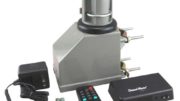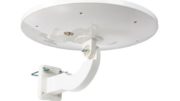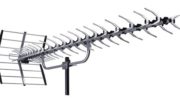Description:
The device is sold for ~ $32 at Solid Signal without any coax.
King Controls SureLock SL1000 Digital TV Signal Finder (SL-1000) from Solid Signal
The claims are:
LED lights indicate where DTV signal is strongest
Variable sensitivity adjustment
Foolproof antenna pointing in both strong and weak signal areas
Also compatible with HD for DTV
Pinpoint the location of local DTV towers
Point the antenna before scanning for channels
Saves time and frustration
Eliminate the need for multiple channel scan
Takes the guesswork out of finding the towers
Simple to use, plug-n-play design
Connects to the antenna TV output or in-line
Positive signal identification
Specifications:
Dimensions: 3.5″L x 3.2″W x 1″D
Weight: .25 lbs
VHF/UHF Frequency: 40-862 MHz (Ch 2-69)
Signal Range: 60-90 dBuV
Power Requirement: 5V DC, 40mA
Battery: 9V PP3 Type (included)
Warranty: 1 year – limited
Kit Contents:
Signal Meter
9V PP3 Type Battery
Coaxial Connectors
Velcro Mounts
Design Description:
Save time and frustration with the King Controls SureLock Digital TV Signal Meter. Quickly pinpoint the location of local DTV towers and begin watching digital television.
pk: The King Controls SL 1000 Signal Finder. This is a rather nice-looking, little LED meter that has four blue signal-level LED indicators, the stronger the signal received, the more blue LEDs light up. The red LED is for indicating the unit is powered on.
Usage:
The idea behind the device is that it senses both VHF and UHF TV frequencies, and up to four blue LEDs will light up, depending on the signal strength. There is a gain adjustment knob so when you have the antenna pointed at a signal and all four LEDs are on, you turn the gain down until only three LEDs are lit. Then rotate the antenna back and forth to see if you can get all four to light up again. I’m assuming that if the antenna is a high-gain antenna, with a narrow beam width, it may require going through this procedure more than once.
Once the antenna cannot be moved in any way to get all four LEDs lit, this should be the best pointing of the antenna towards this signal.
In many places, the TV signals share a tower, sometimes even sharing the same antenna, so you’re probably looking at more than one signal coming from the direction your antenna is now pointed. Lists and directions of TV stations are available from TV Fool all one really needs to enter is a zip code. I tried ZIP, ZIP+4, complete address with zip+4, and last, the complete address with just the basic zip code. I found no difference between zip code and zip + 4 in either case, but there was a difference in using just the zip code vs. using the completed address with the zip code. I recommend using the complete address with the zip code to get the best results. Also, I find that TVFool is very optimistic in its predictions of which stations you can receive.
Another tool is at: AntennaWeb – Address
and here I find that this tool is very pessimistic in its predictions of stations you’ll be able to receive. One way to find as many stations as possible using this tool is to set your antenna height to the maximum allowed. To do this, click the radio button next to “yes” for the question, “Will the antenna be installed more than 30′ above ground level?”
When I did this for my location, it found the same stations from Baltimore, Frederick, and Washington D.C. that TVFool found.
Test Descriptions:
I used two different tests to test for two different things.
Test 1: This test was for testing how well an antenna could be pointed using a simple antenna, in this case a UHF bowtie antenna (BT).
Test 2: This test was to see if I could figure out the steps between each of the SL1K’s LEDs. This test was done with my own design for what I call a Four Element Turnstile Bowtie antenna with Gain. Or, as my wife likes to call it, the porcupine antenna.
Test 1:
In this test of the SureLock SL1000 (SL1K), I used a home-brewed UHF bow-tie antenna which is a basic wide-element dipole with ~73 Ohm impedance. It was connected to the SL1K without using a 4:1 TV 300 Ohm-to-75 Ohm impedance transformer.
Photo 1. Home Brew Bowtie Antenna on a Stick
Bowtie on a Stick
The test was done at my location of ~ 26 miles north of Washington, D.C. and 26 miles west of Baltimore, MD. Using my BT antenna, it showed only one LED for Baltimore and one for Washington. I was never able to get this set-up to light up more than one blue LED and the gain control had no effect. It would not light up a second LED when full gain was applied nor was it able to turn the one LED off when it was set to minimum gain.
Still, even with only one LED going on and off as I turned the BT antenna, I was able to point it at either Baltimore or Washington. When a TV was connected, I was able to receive stations from both cities, as long as I pointed it for the station/city I wanted to view.
Test 1 conclusion:
I used the simplest antenna possible so most any other antenna, with gain will cause more than one LED to light up. In fact, I tried my best four-element bowtie antenna and it managed to get three to light up. Even with only one lighting up the antenna was able to be pointed sufficiently well to receive TV stations.
Test 2:
On Friday 03/15/2013, I tested the SL1000 (SL1K) again. This time with my first home-brewed Four Element Turnstile Bowtie antenna mounted on my roof and comparing the signal level of the SL1K to a good signal the antenna was picking up from Baltimore Ch 13.
Photo 2. Four Element Turnstile-Bowtie Antenna, AKA The Porcupine Antenna
Porcupine Antenna
I first tested with the WinTV-HVR 950Q (Q) to see what the signal was doing. I found the strongest station and it was solid at SNR 27 & 0 errors. It wasn’t until I added 27 dB that there was anything lower than SNR 27, and not until I added 36 dB of attenuation that the signal level dropped from green to yellow SNR 15.8 – 16, still with 0 errors.
I then attached the SL1K with the 36 dB and it wasn’t until I reduced it to 3 dB that the SL1K even registered a single LED lighting up one of the four LEDs. At 6 dB, even that LED was extinguished and could not be brought back on, even with the gain control turned fully on.
I measured the 9V battery and found it at 9.39V with power off, and 8.74 with the power on and only the power LED on. I then found another 9 V battery that at least stayed above 9 V when the power LED was on.
Off: 9.50V
On: 9.35V (only the power LED)
1 LED: 9.35V (red power LED & 1 Blue signal LED)
The SL1K still shows one LED with 3 dB of attenuation and no LEDs with 6 dB of attenuation.
Conclusions:
1. From no signal LED to one LED is less than or equal to 3 dB.
2. The gain control min to max is less than 3 dB.
Understand that these are tentative estimates because the SL1K did not have enough signal for me to really tell what was going on and I did not have two 1 dB attenuators to see if the steps between the LEDs was ~ 1 dB.
I have to admit that I was more than a bit surprised at the lack of sensitivity of the SL1K and the lack of gain of its gain control. I expected at least a 3 dB spacing between the LEDs and at least a 6 dB gain difference using the gain control and 12 dB would have been much better so we can get four doublings of power before having to use any attenuation to reduce the strong signals. Are the LEDs about 1 dB apart?
I guess that this means that if four LEDs are lighting up and not even one LED can be turned off by lowering the gain control to zero, it really doesn’t matter much since there’ll be more than enough signal to watch TV.
At the other end of the scale, even with only one LED lighting up, the signal level was 36 dB above the minimum needed to watch TV. Whether this is enough to weather any storm or condition so that the station will never be lost is another question, and one I cannot answer for you, your location, and your antenna.
In my location with the antennas I’ve tried so far, I have noticed variations in signal quality that have caused a station with 36 dB above minimum signal to have problems due to weather events. We do need to remember that simply because the signal level is good, this may not mean that the signal is worth watching. The old analog days of TV signal fading gracefully are gone. We now have things such as Bit Error Rate (BER) which can fall below the minimum threshold due to noise interference which will cause the signal to be lost; the TV will not be able to decode the digital signal.
I asked someone at King Controls to comment on my observations and here is part of what Steve Bein sent back:
[QUOTE]
Background – King Controls is located approximately 20 miles away from the three broadcast towers in Shoreview which is north of our facility. We have several types of amplified and non-amplified antennas currently positioned at these broadcast towers. Our antenna farm is located on the roof of our facility (roughly 30 ~ 35’ off the ground) the topology for our location is that we sit approximately 800’ above sea level with the broadcast towers close to 900’. From the roof of our facility there are no direct obstructions (only some buildings in downtown Mpls 10 miles in the distance) between us and the towers.
I used five non-amplified antenna designs (see list below) and tested the SL1K to determine its sensitivity to broadcast signals under the conditions mentioned above. I was able to get up to three LEDs to light up for maximum signal with all five antennas when pointed directly at Shoreview which then dropped down to two, and then one LED as the antenna was rotated to the south away from any broadcast signals.
Ant list:
Antenna Direct – C2 Clear Stream 2
Winegard – Free Vision model FV-HD30
A Channel Master HDTV model 2016 and two similar models UHF/ VHF HDTV antennas:
In conclusion the Surelock SL1000 works as intended; a simple RF signal meter to determine the possibility of a broadcast tower in the distance by the illumination of one or more LEDs when the antenna is rotated toward the broadcast tower. The Surelock SL1000 was designed without internal gain therefor it is not ideal in extremely remote locations without the aid of an in-line RF amplifier or an amplified antenna system.
Steve Bien
[/QUOTE]
Thanks Steve! Here is the information I was able to find about the three antenna model numbers listed:
Antenna Direct – C2 Clear Stream 2
—–
Distance up to: 50 miles
Gain: 10.2 dBi – ?Best HDTV Antenna (For Cities) | The Wirecutter
—–PhilK
Winegard – Free Vision model FV-HD30
—–
Distance up to: 30 miles
Gain: None stated that I could find. I have asked for more information.
Outdoor TV Antenna, UHF VHF HDTV Antenna – Winegard FreeVision
—–PhilK
A Channel Master HDTV model 2016 and two similar models UHF/ VHF HDTV antennas:
—–
Distance up to: 35 miles
Gain: 0 – 9.5 dB depending on the channel (Good information!) -PhilK
http://support.channelmaster.com/attachments/token/tk870ics5baqf50/?name=CM20xx+Series+Data+Sheet.pdf
—–PhilK
Conclusion:
The King Controls SureLock SL1000 most definitely helps in pointing an antenna, even a simple one such as a UHF Bowtie antenna, with the unit only having one LED lighting up. With an antenna having substantial gain or if you are closer to a tower, or both, you can expect more LEDs to light up and be even more helpful in pointing the narrower view of such an antenna.
If I were to make any improvements, it would be to add some gain to the unit so that when there is only one LED on with the gain set to minimum, it would light up at least three LEDs, preferably all four when the gain is at its maximum setting. I may feel differently about that suggestion once I test my claimed 20 dB gain UHF antenna.
As I test more antennas with the SL1K, I will post the results here.
Until next time…





